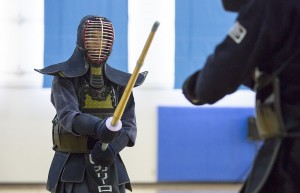The original version of this article contained an error and has been changed. See the bottom of the article for additional information.
Yelling resonates throughout the entire second floor of the John Wooden Center.
Some yells are long, some are short. Some yells are high-pitched shrieks, while others are deep, guttural sounds. But they’re all intense, and they’re all constant.
These distinct yells every Monday, Wednesday and Friday night signal that practice for the UCLA Kendo Club has commenced.
In kendo, a Japanese martial art similar to fencing, competitors use reinforced bamboo staffs called shinai in an attempt to strike their opponent in the neck, wrist, abdomen or head. Competitors typically wear bogu, or protective equipment. All the while they yell, in a traditional part of the practice called kiai.
While kiai sounds like a warrior’s battle cry, it also serves as a projection of one’s fighting spirit. Through kiai, a fighter can overcome his or her own fears.
“Kiai is a vocalization of spirit,” said Joshua Chan, third-year physiological science student, club captain and external vice president. “Kiai is a projection of confidence. It’s your fight that you have inside you.”
Traditions, rituals and etiquette like kiai are all deeply woven into every aspect of kendo, and date back to Japanese samurai in feudal societies.
Before fighters can demonstrate their kiai, however, they have to properly enter the dojo, and prove they are worthy of a fight.
After removing her shoes and donning her bogu, Rachel Carrillo, fourth-year economics student and club president, stands at the edge of the hardwood floor of her John Wooden Center dojo and yells, “Konbanwa!” over the voices of her fellow club members already practicing in the studio.

“Konbanwa!” answer 30 voices in unison, not even breaking to pause their shinai-bashing and kiai-practicing.
After Carrillo sets her belongings down, practice begins. The club gathers in rows at one end of the studio to begin across-the-floor drills. After a quick scolding from coach Nathan Makino to keep his students’ rows straighter, the drills commence and the kiai overwhelms the studio.
Each student has his or her place, and knows it well. Carrillo heads to the front of the line. A first-year passes Carrillo on her way to the back. Though she has four more years of experience than Carrillo, she is still a first-year and must display respect for her elders.
“You must know your place and stay there,” said Melody Wang, fourth-year applied linguistics student and club internal vice president. “Never walk in front of someone. If someone knows more than you, acknowledge them.”
During the course of one practice, students are reprimanded countless times for letting their eyes wander, and failing to maintain eye contact with their coaches during warm-ups. Cellphones are not tolerated, nor are uneven lines or forgetting to personally consult with and thank every coach after each practice.
In kendo, etiquette and ritual are important because for the competitors, the practice isn’t simply a sport. It’s a display of character development through swordsmanship.
“Sports are about competition,” Makino said. “The difference between having rituals and etiquette and not is the difference between violence and self-control.”
While kendo is a contact sport, with points awarded by three judges for strikes to the specific body parts, the goal is never to harm an opponent. Rather, one should demonstrate his or her own character and respect by becoming stronger together with one’s opponent.
In kendo, every movement, every glance and every utterance counts either toward or against one’s character. Each aspect is based on respect for elders and higher-ups.
While competitors in other martial arts wear colored belts to display their skill levels, in kendo, the individual displays and proves his or her ability with every fight. Many of these forms of etiquette stem from everyday culture and respect in Japan.
“It’s considered rude if you don’t have the correct form of greeting,” Chan said. “If you live in Japan, it’s definitely part of everyday life. You’re improving your kendo, and you’re improving your person as a whole.”
At the Yuhihai Intercollegiate Kendo Tournament on Sunday in the Student Activities Center, kendo students faced countrywide competition and tested their personal character and physical abilities.
Carrillo stepped onto the wooden floor, her entire body covered in bogu. She was the second member of her five-person team to take on the California Kendo Club in the tournament’s semifinals.
Bouncing on the balls of her feet, she perfectly positioned her shinai to defend strike after strike, waiting patiently for her cue to strike back.
After her opponent’s last attack, she charged in and the two competitors tightly circled each other, face to face, shinai pressed together, sizing up the competition. A few tense seconds later, Carrillo yelled in her opponent’s face and backed away, poised to charge. In less than a second, she had run across the floor and was now on the opposite side of her foe, striking her shinai against his head and yelling as she ran.
After the remaining three fighters had finished, Carrillo and her team stood in a precisely straight line, bowed to their opponents and walked off the court. While the UCLA team placed third in the team division, it did finish first and third in the women’s division, third in the Kyu division and swept the non-bogu division in first, second and third.
“Everything must be completely in unison,” Carrillo said. “You have to be on the same wavelength as your teammates. You breathe as one. Breathe together, live together, die together.”
Correction: The UCLA team placed third in the Kyu division.
